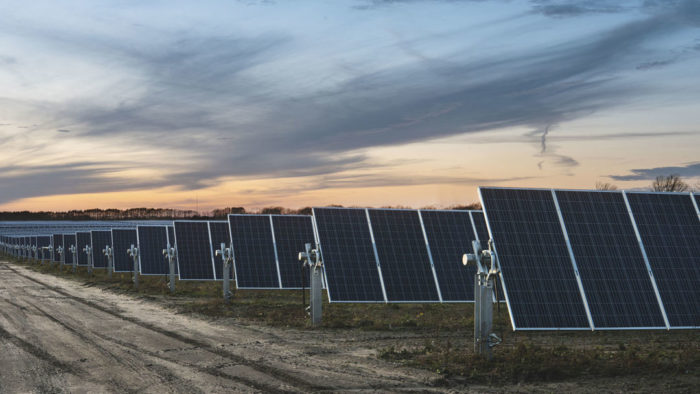
Image Credit: Swinerton Renewable Energy
This article was originally published at Yale Environment 360 and is reprinted here with permission.
Drive through the frosty stubble of central Minnesota soybean and cornfields this winter and you’d come upon a surprising sight — acres and acres of solar panels glinting under the northern sun. The 1,000-acre North Star Solar farm, which opened in December, is the largest, most northerly solar power plant in the United States, generating up to 100 megawatts of electricity, enough to power 20,000 homes. Prone to smothering blizzards, subzero temperatures, and scant sunlight for much of the year, this boreal clime seems an unlikely spot for a major utility-scale solar installation. But the North Star facility will soon be joined by a 100-megawatt solar plant in neighboring Wisconsin set to break ground later this year.
Thanks to sharply falling prices for solar photovoltaic panels, rapid advances in harvesting the sun’s energy, and support from tax breaks, incentives, subsidies, and state renewable energy mandates, a clean energy technology once largely confined to the desert Southwest is now quickly extending its reach. Idaho and Maine recently opened their first multi-megawatt plants. Alabama, Iowa, Kentucky, and Nebraska are also making their first forays into utility-scale solar, while Florida and Georgia are in the process of super-sizing their existing capacity.
Throughout the United States, more than 10.5 gigawatts (10,500 megawatts) of utility-scale solar was added to the electric grid in 2016 — enough to power more than 2 million homes — and more than 8 gigawatts are scheduled to come online this year, according to a new industry report. Led by utility-sized projects (generally 10 megawatts or larger and producing electricity to sell), the total U.S. solar capacity — including photovoltaic panels on the roofs of homes and buildings — is expected to nearly triple over the next five years.
“Minnesota is not the first place you think of to build a big solar project, but there have recently been several projects in the 50 to 100 megawatt range built there,” says Mark Bolinger, a scientist at the Lawrence Berkeley National Laboratory who conducts an annual analysis of utility-scale solar costs and trends. Bolinger says wholesale power prices from the new Minnesota solar plants are around 6 cents per kilowatt hour — numbers formerly seen only in places like Arizona and New Mexico. “I think that’s a good indication that solar is really starting to find its legs and is able to compete more broadly across the U.S.,” says Bolinger.
Increasingly, competitive without incentives
Indeed, electricity produced by new utility-scale solar facilities these days can be as cheap as, or cheaper than, electricity from new conventional coal-fired or natural gas-fired facilities. Government support has helped lead to this “price parity,” but increasingly solar energy can compete without state or federal incentives.
The utility-scale solar boom is resounding globally. A just-completed 648-megawatt plant in the southern India state of Tamil Nadu, said to be the world’s largest, will power up to 150,000 homes; it will soon be topped by a 750-megawatt solar plant under construction to the north in Madhya Pradesh.
China has been building solar at a furious pace, accounting for nearly half of the 76-plus gigawatts added worldwide in 2016. Utility-scale solar is poised to take off in Australia this year, with 11 new facilities being built across four states, and large projects are in the works everywhere from a behemoth 1.18-gigawatt installation in the United Arab Emirates, to a 180-megawatt facility in Peru. Even Ukraine’s radioactive wasteland at Chernobyl may soon be the site of a massive 2-gigawatt solar farm.
Solar pipeline at an all-time high
With more than $20 billion invested in the U.S., the solar pipeline is now at an all-time high, according to a new analysis by GTM Research and the Solar Energy Industries Association (SEIA). Nearly 18 gigawatts of upcoming utility-scale projects are currently under contract in the U.S., meaning plant operators have signed power-purchase agreements and the facilities are highly likely to be completed in the next two to three years.
This surge of large solar energy installations will nearly double the roughly 5 million U.S. homes now powered by utility-scale solar. What’s more, projects totaling an additional 36 gigawatts are now in the planning phase, according to statistics compiled by the SEIA.
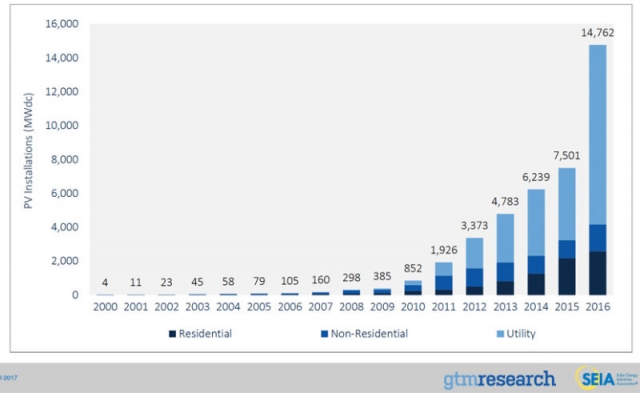
Some of these projects are being developed by solar energy companies and sold to private investors, which then sell the electricity to public utilities or independent power producers. Other projects are built and owned by utilities or their affiliates. The new Minnesota installations are part of a state effort to meet its 25% renewable energy standard, set by the legislature in 2007 and signed by then- Governor Tim Pawlenty, a Republican. The $180 million North Star Solar plant, the largest, was commissioned by Xcel Energy, a utility holding company based in Minneapolis.
Under the U.S. Department of Energy’s SunShot Initiative, research and development projects aimed at making solar energy costs competitive with conventional sources of electricity worked so well that the program reached its price targets — 6 cents per kilowatt-hour for utility-scale systems — three years ahead of schedule. The target has now been reset to 3 cents per kilowatt-hour by 2030.
Days of uncertainty ahead
The SunShot program gave a major boost to U.S. solar energy development. But its days, and those of other federal renewable energy programs, may be numbered. The Trump administration is now wholeheartedly embracing fossil fuels, dismantling Obama-era environmental initiatives, and cutting funding for clean-energy research and development. In his 2018 budget, President Trump pulled funds for the Clean Power Plan, a key Environmental Protection Agency regulation reducing carbon emissions from power plants, which would have given an additional boost to renewables.
Loan guarantees and other federal programs that have helped drive clean energy development are also on the Trump administration’s hit list. The budget calls for reducing funding for renewable energy projects at the Department of Energy and its national laboratories by 18 percent. While the budget is preliminary and subject to revision by Congress, the climate of uncertainty is unsettling for the solar industry.
“Who knows what’s going to happen?” said Daniel Kammen, an energy and resources professor at the University of California, Berkeley. “The situation has put a rush on projects that are in planning… and put a worry in investors in the long-term.”
The most damaging impact for utility-scale solar in the U.S. would come if Congress rescinds the 30% Business Energy Investment Tax Credit, a key tool for solar energy development. The credit, initially set to expire at the end of last year, was extended another five years by a Republican-controlled Congress in 2015.
Economics are now the main driver
Even without government backing, analysts say the costs of utility-scale solar are dropping so quickly that economic realities, rather than incentives and regulations, are now the industry’s main driver.
Georgia Public Utilities Commissioner Lauren “Bubba” McDonald can attest to that. The conservative southern state went from having almost no utility-scale solar a few years ago to becoming the third-largest installer in 2016 — with no government subsidies, tax incentives, or renewable energy mandates. “Zero,” McDonald says. “Free-market.”
McDonald led the effort in 2013 when he noted steep drops in solar panel prices. The state utility, Georgia Power, was about to issue a request for new generating facilities to meet rising electricity demand.
“They did not have one watt of solar power [included in their plan],” McDonald says. “I went to the power company and said, ‘We can do this as partners or we can do it as adversaries — if we’re partners, and it works, we both win.’”
The result: “We put in 525 megawatts of utility-scale solar.” Georgia has since commissioned an additional 1,200 megawatts, and now has more than $1.9 billion invested in solar of all types, he says. Next-door neighbor Florida has followed suit, switching on three 74.5-megawatt solar plants last year, with four more to come in 2017. North Carolina and Texas also have big projects underway.

Utility-scale solar’s progress is so striking that even some former skeptics have changed their minds about the industry. Robert McCullough, a long-time energy analyst, says he used to consider utility-scale solar’s prospects as basically hype. “I’d been hearing that all of this is just around the corner, and then one day it was staring me in the face,” says McCullough, principal of the Oregon-based industry consulting firm McCullough Research. In the past couple of years, he said, cost shifts have been so astonishing that “now we have really quite a revolution going on… The scary thing is you’ve now heard this from a cynic.”
In the past seven years, the price tag for utility-scale solar in the U.S. dropped 85%, as equipment prices plunged, manufacturing techniques improved, and developers gained experience that enabled them to build projects more economically.
Beyond the stronghold in the West
While Western states still dominate the industry — more than 77% of the solar power generated nationwide last year came from west of the Rockies, according to the U.S. Energy Information Administration — solar is marching northward and eastward.
Increased photovoltaic panel efficiency and other technological improvements are leading the way. New designs allow photovoltaic modules to harvest weak early morning and evening light, making short days longer. Trackers that follow the sun across the sky increase yield, enabling projects in cloudy places like Oregon. And in Minnesota, the “unique challenges of a colder climate,” as North Star Solar developer Chase Whitney of Community Solar Energy put it, have been addressed with solutions like panels that can essentially shake off snow.
Obstacles do remain. The nation’s outdated transmission system can’t efficiently handle the renewable energy influx. Peak output from solar and wind farms is often wasted by an overloaded electric grid. More and better electricity storage is urgently needed. And in addition to federal efforts to thwart clean energy programs, numerous Republican-controlled state legislatures are considering legislation to reduce or eliminate funding for renewable energy incentives and initiatives.
But with falling costs and a jam-packed pipeline of projects ahead, analysts say big solar should be able to maintain its momentum without the government at its back. “It all ties back to economics,” Kammen says. “No political party can deny how much progress has been made on prices for wind and solar — but in particular solar — in the last few years.”
Georgia’s McDonald agrees. “The sun’s going to shine 60 years from now,” he says, “and those electrons are free. They’re free to me, they’re free to utilities, they’re free to everybody.”
Cheryl Katz is an independent science writer whose work has appeared in Scientific American, National Geographic News, and Hakai Magazine, among other publications.
Weekly Newsletter
Get building science and energy efficiency advice, plus special offers, in your inbox.





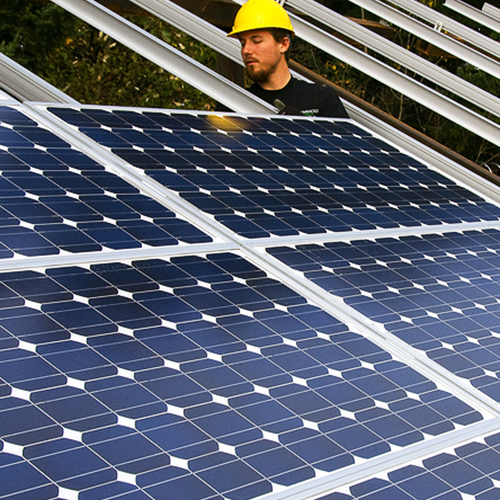
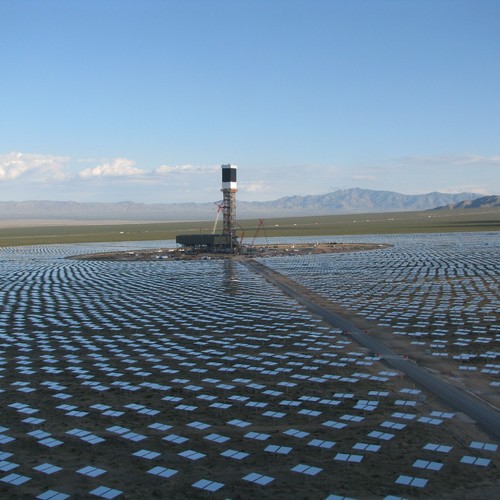
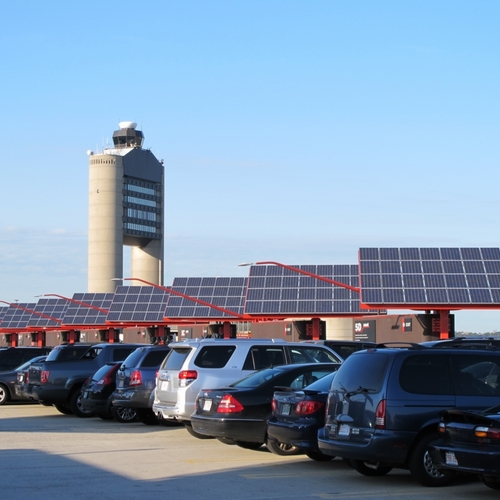







0 Comments
Log in or create an account to post a comment.
Sign up Log in